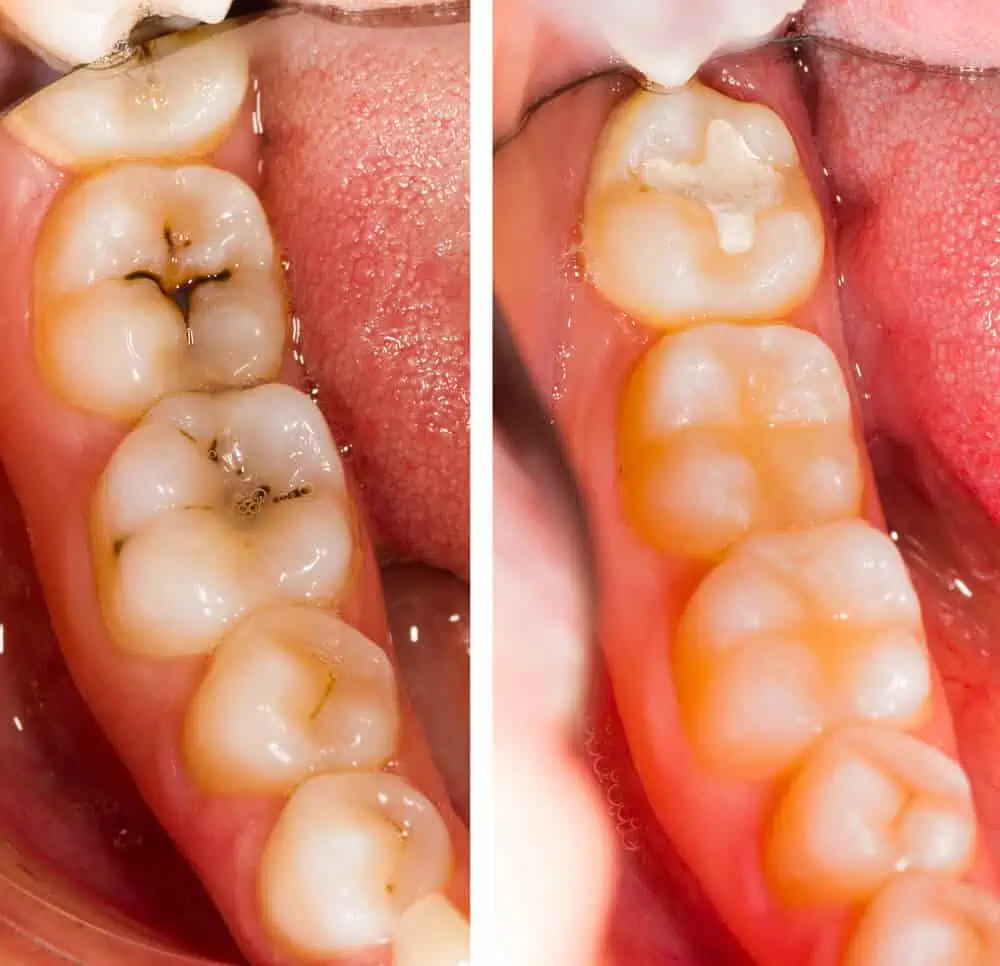Have you noticed that your dental filling fell out and are wondering how to fix it? There are many reasons for fillings to come loose. Some are caused by bad habits or accidents and others are a result of regular use over time. When you have a loose or missing filling you may experience symptoms such as:
- Tooth pain where the filling used to be
- A visible gap or hole in your tooth
- Increased sensitivity to hot or cold
- Hard material in your mouth from the broken tooth filling
Regardless of filling type or why it fell out, and even if you have no pain, when you have lost a filling you will want to contact a dentist to schedule a repair or replacement, and receive advice on how to care for your tooth in the interim.
You can find a dentist by calling 866-383-0748. You’ll speak with a live operator who will put you through to a dentist in your area.
Dentaly.org wants to help you understand what to do when you have a broken or loose filling. So, we’ve put together this brief overview of causes, prevention and treatment for missing fillings. We hope that the guide below will address all your questions about why your filling came out and what to do in order to restore your smile.
How come my tooth filling fell out?
Fillings by their nature are not permanent and can fall out for several reasons. One of the most common reasons is biting down on a piece of hard material, causing a filling to crack or come loose. However, there are other causes that can take place over a longer period of time.
Sometimes a filling may fall out due to decay around the filling, which slowly releases it from the tooth. Some habits like grinding your teeth while you sleep or clenching your jaw during exercise can also gradually cause damage to fillings, resulting in them falling out. If your new fillings fell out shortly after being put in, it could just be that they never properly bonded with your teeth in the first place.


The material used for your filling also affects the way that it may break or become loose. For example, amalgam fillings and gold fillings are much less brittle than composite and glass ionomer fillings and so are less susceptible to damage from chewing. Beyond their risk of breaking, non-metal fillings also tend to lose their binding to the tooth and fall out earlier.
If you want to know how long fillings should normally last, you can watch this video:
What to do when a cavity filling falls out
A dentist knows best what to do if a filling falls out. If you notice that your filling has come loose or fallen out, you shouldn’t delay in making an appointment. Although it is not usually considered an emergency, a missing filling can leave exposed nerve tissue and will not be able to heal on its own. You should also rinse your mouth out very thoroughly with saltwater in order to ensure there are no remaining pieces of filling. Otherwise, they could become lodged in the exposed area.
You can follow these guidelines to protect your tooth while you wait until your filling is replaced at the dentist:
- Use a temporary filling: Most pharmacies sell dental wax or temporary filling material that you can put in place while you wait to see a dentist. This will effectively protect your tooth and nerves for a short time but should not be used for more than a week.
- Avoid chewing with your affected tooth: It may seem obvious, but it’s important all the same. If you bite down on something with an exposed nerve, it can be extremely painful and cause serious damage.
- Treat pain with over-the-counter medication: If you are experiencing pain, you can treat it with painkillers like ibuprofen or by applying a cold compress on the outside of your mouth as near as possible to the affected area.
If you can’t immediately access the care you need in person, you may want to schedule a consultation with a dentist online. Find out more about this process in our teledentistry guide.
Options for replacing a lost filling
No matter what the cause may be, when you notice your filling has come out there is only one thing to do: call a dentist and schedule an appointment for a new filling as soon as you can.
Your dentist will give you a choice of materials for your new replacement filling. Depending on the size, location, and visibility of the cavity you may have different preferences, so check out this chart for information on the different materials used for fillings:
Type of filling | Color | Lifetime |
Amalgam | Silver/gray | 10-15 years |
Gold | Gold | >15 years |
Composite | Off-white | 5-10 years |
Glass ionomer | Off-white | 5 years |
Temporary filling | Varies | 1-8 weeks, depending on type |
If you are interested in a temporary filling, you can use one of several tooth repair kits available for over-the-counter purchase.
DenTek Temparin Max is a filling repair kit that, according to customer reviews, works well. In addition to providing a temporary cover for your tooth, the formula also provides pain relief until you can get to the dentist.
Temporary fillings
When you need short-term protection while you wait for a permanent filling, you or a dentist may place a temporary filling on the affected tooth. These fillings are not designed to last long. Therefore, they require more caution than a regular filling when eating, brushing, and flossing.
How do I keep my temporary filling in place?
Because temporary fillings are not designed as a permanent solution, it’s important to care for them while you wait for a permanent filling so as to avoid harm to your sensitive tissue. When dentists place temporary fillings, they will give you instructions on how to care for it. In addition to those instructions, here are some general tips on care for your temporary fillings:
- Avoid chewing with your temporary filling: Especially during the first 24 hours after placement, it is important to disturb your temporary filling as little as possible, as they usually will require a day to dry and set. After the first day, it’s still a good idea not to chew with it in order to minimize the possibility that you dislodge or damage it.
- Keep your tongue away: Having new dental work often causes people to feel it with their tongue. In the case of a temporary filling, consistent pressure from your tongue can cause it to come loose.
- Brush and floss carefully: You should be sure to maintain your regular oral hygiene routine with a temporary filling, but always exercise caution in the area of the affected tooth. Brush softly, and when flossing, don’t pull the floss directly up (or down) out of the gap between your tooth. This can pull the filling along with it. Instead, gently remove the floss by pulling one end out and running the length of the floss through your teeth to avoid disturbing the temporary filling.


What happens if my temporary filling falls out after a root canal?
After a root canal, your dentist will put in a temporary filling. These fillings are designed to last longer than an over-the-counter equivalent because they are protecting a very sensitive part of your mouth while it heals enough to place a permanent filling.
This also means that if your temporary filling fell out after a root canal, you should get in touch with a dentist right away. A temporary filling that falls out after a root canal is especially important to replace as soon as possible.
How to prevent fillings from falling out
Fillings are not truly permanent, but with proper care they can last many years before they need to be replaced. According to the ADA, it can be very difficult for you to recognize when a filling is starting to wear out. For that reason, regular visits to the dentist are necessary. A dentist can identify problems with your filling by examining it for cracks and other signs of wear, as well as ensure that it is still well sealed to the tooth using a tool known as an explorer.
When a dentist confirms that a filling is beginning to wear out, you should have it replaced promptly so as to avoid a situation where it falls out and you are left with exposed tissue.
Conclusion
There are several different types of tooth fillings with different characteristics, but any one of them can come loose or fall out. If you find that your cavity filling fell out, although you can perform a temporary fix, it’s best to contact your dentist and make an appointment for a replacement as soon as is convenient.
If you’re unsure what to do about your lost filling or you need pain medication urgently, you can connect with a dentist by calling 866-383-0748. You’ll be connected with a qualified dentist in your area.
FAQs
How do I know if my filling fell out?
You will usually notice a piece of hard material in your mouth that was your filling. Sometimes you may not notice because it came loose while sleeping or eating. You will probably realize that your filling fell out from other signs such as pain, increased sensitivity, or even just by seeing in the mirror that it’s missing.
Is a filling falling out an emergency?
Normally a lost filling is not considered an emergency, but it should be addressed as soon as convenient. If your filling falls out, make a dental appointment within the next week for a replacement. In the meantime, chew carefully and use painkillers, dental wax, and temporary filling kits as necessary.
How do I fix a filling that fell out?
If your filling falls out, there are some things you can do for your tooth from home, but it’s never recommended that you try to permanently fix it yourself. For the best result, call a dentist to replace your filling. At home you can use oral gels or at-home temporary filling kits to protect your tooth while you wait for your appointment.
How long can you keep a temporary filling in?
Temporary fillings are just that—temporary. Some, like after a root canal, are meant to last for several weeks, but any temporary filling placed at home shouldn’t be used for more than a week. The purpose of such a filling is protection while you wait to see a dentist.
American Dental Association: When a Filling Needs to be Replaced. Consulted August 3, 2020
American Dental Association: Dental Filling Options. Consulted August 3, 2020




